London & Paris Fashions June 1906
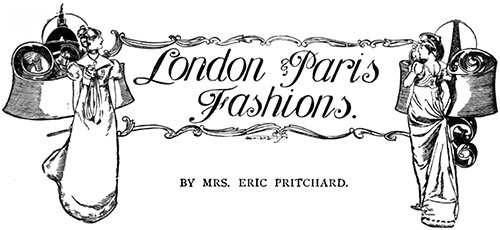
Nothing could be more striking than the beautiful fashions displayed for this month, and a most interesting note is the absolute contrast in a woman's dress. Every historical period seems represented, but nothing is so definite as last season.
For instance, one could fill pages with the modifications of the Empire frock, and deviations from the Princess and corselet modes.
On one side, one sees quaint flowered taffetas, stiff frills, and pleatings, giving an idea of the early Victorian fashions, and on the other, a long, clinging, serpent-like skirt of, say, soft rose crépe de Chine, pailletted all over with a design of glittering sequins, worn with a simple bodice and perhaps a hat of Reynolds shape, with a parasol à la Pompadour.
No hard and fast rules are laid down by the authorities of Paris and London, and we appear to be in the midst of a pleasing variety and assert the right to wear whatever we please both in color and design.
To cut matters short, I should say that in the evening we are gorgeous and, in the day, simple, at least for the morning, though I hardly think our dress can be called simple when beautiful white embroidered linen frocks are worn. How delightful they sound!
Moreover, they are excellent for town wear, but nothing will ever convince me that linens are cool.
That these embroidered linens will become vulgarized as the season advances there is no doubt, and directly we get to the mixing of colors it is dangerous; consequently, to my mind, the smartest are plain white linen blouses or coats and skirts with a chic leather belt around the waist.
There is an exquisite simplicity about these which is always charming. When we come to the more elaborate style of linen frock, it behooves us to be careful, or we lose the idea of the smart garment for practical wear in the morning.
Charms of Alpacas and Tussore
Now before I get on to the all-entrancing subject of Ascot modes, I wish to call attention to the charms of alpacas and tussores from the practical point of view.
Tussore, of course, can be as smart as you please, and run up to any price; at the same time you can get very inexpensive, simple ones for the morning in every variety of color. Coarse makes are the smartest; also, they are cool and dust-resisting.
There is a fancy for golden-brown tussore, Saxe blue, and a unique cinnamon shade, not to speak of the always popular white and grey and the beloved Vieux-rose of the moment.
In alpacas, dark green check effects, blue stripes, and white with black stripes strike a new note for the smart tailor-made. I think alpaca, being a hard and wiry fabric, is best treated in a rather severe and straightforward style.
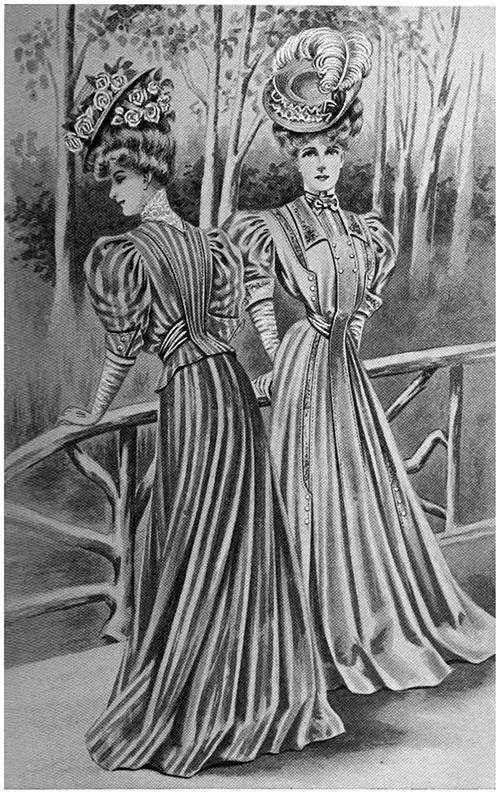
Figure 1: Two Examples of Alpaca and Tussore Frocks
A beautiful illustration of a Tussore frock is in fig. I, on the right-hand side. There is nothing neater or nicer than these alpacas, and they are very practical to wear for the ordinary woman, who has to travel by rail, motor, and even motor buses, besides walking, paying calls on foot, etc.
Bedraggled finery is never smart, and alpaca, like Tussore, do good service for the next two or three months without showing signs of wear. It is curious how serges, both in fine herring-bone and very coarse ribbed effects, are holding their own.
The skirts of these may be unlined and worn with smart little coatees over linen and lawn blouses. There are many dull days in the English summer when muslins and flimsy, silky fabrics look woefully incongruous and dreadfully chilly.
Alpaca, in very fine makes, is being also used for more dressy occasions, but it is infinitely smarter as tailor-made with a short basque coat or little-fluted bolero.
Indeed, a leading Paris house is making one of their best tailor models in coarse white alpaca with a swallow tail, Louis cut-away coat with a plain, long skirt of the riding-habit order, heavily braided with coarse white braid.
Always charming in the world of fabrics are delaines—in fact, there are all kinds of woolen materials this season of the delaine order, as well as cashmere with funny little stripes, spots, checks, and patterns thereon, all made up with a touch of taffetas or velvet as a trimming and heavy guipure embroideries.
Smart Tailor-Mades
Among smart tailor-made, white cloth and coarse white oatmeal-cloths will be worn with heavy Irish crochet waistcoats or bright-patterned silk ones. Of course, such a frock is an individual one, and it is not a good idea for the public to adopt indiscriminately, for the colored waistcoat must be treated with care and worn with discretion.
The quantity of heavy laces used is an extravagant feature. These appear on fabrics as well as on lighter materials. Cloth, of course, in the most exceptional makes and pastel shades finds a place in every woman’s wardrobe, and for those who cannot afford them I recommend the fine serges which wear well, clean well, and are a cheaper purchase, to begin with.
Then the check woolen materials are brilliant, and coarse ribbed materials in light greys, fawns, and cream effects with black stripes running through can be very chic. Small spots and broad lines are a feature of some of the best gowns.
Many of the lovely frocks in preparation for Ascot are composed of light fabrics with white grounds and colored designs. It is useless to preach economy for Ascot frocks unless it is for the young girl who may look charming in muslin.
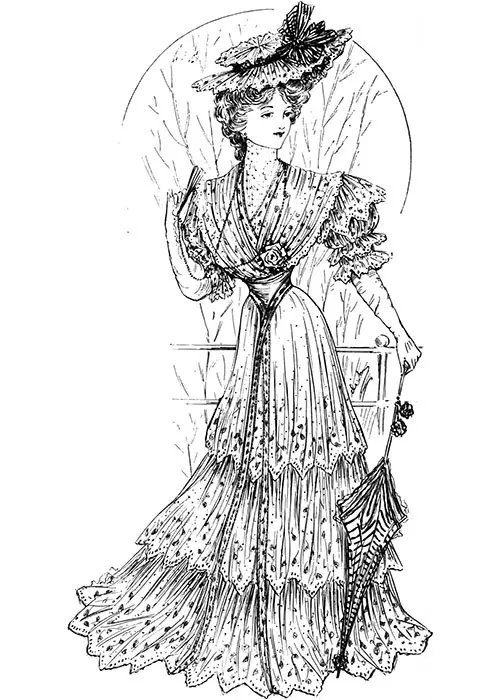
Figure 2: Lace Frock for Ascot
However, the typical Ascot frock must be magnificent. In fig. 2 we have a delightful sketch of a cool, summery, and gorgeous garment.
Lace is, as sporting people would say, “bad to beat” for general effect, but having thrown economy to the winds, let me warn everyone who attempts the lace dress (which need not necessarily be expensive, for pretty, old-world patterns are reproduced at extremely moderate prices, and only require a layer of chiffon beneath to throw up the design and soften the whole thing) never to put it on to a foundation of glace, but over soft Oriental satin or pongee. I do not think anything is uglier than a lace or muslin dress over a crackling foundation.
What a rage there has been for point-d’esprit this season, and here we have an example of a reasonably priced fabric worked up into wonderfully elaborate garments.
Fine Valenciennes lace and coarse guipures are popular, and many delightful models are trimmed with ribbon ruchings or Pompadour edgings and sometimes black velvet, which is always effective with lace.
Here, again, soft, creamy chiffon will throw up and significantly enhance the value of an ordinary washing point-d’esprit.
The Loveliest French Frocks
The most lovely French frocks are made of painted muslin: chiffons and gauzes are also painted. Sizeable white velvet buttons worked in with gold and silver, or quaint old enamels are a favorite finish to some of these light summer frocks.
Buttons still form an essential item in the world of trimmings. Large gold medallions or diamond shaped pieces of colored velvet, sometimes edged with lace, are a somewhat unique mode of decorating a bodice and even form an elegant finish where nothing else would correctly do.
One of the favorite Ascot colors is shrimp-pink in soft ninon-de-soie éolienne, etc. Real rose has been a favorite for a long time: but this wants toning down with a good deal of lace.
Every shade of blue from pale Saxe to a vivid royal is to be seen, and a few fashionable frocks are in the palest tone of eau-de-nil.
There are, too, some glamorous gowns in crepe-de-Chine and fine white cloth with a border of beautiful hand-cut jet and bolero to match.
These are chiefly cut in corselet or Princess style and are very plain but magnificent: they are at their best worn with a black hat, and perhaps a touch of color in the long-handled Pompadour parasol.
A curious compromise in parasols is the Early Victorian frilled silk shade, with a long Louis XVI stick finished with gold or silver cords.
These long handles look very well carried out in inlaid tortoiseshell and crystal, but nowadays there is a craze for something odd yet straightforward in the way of stones.
One of the most beautiful things I have seen is a large knob of uncut opal with an arrow rim of gold: this was most uncommon, and, I may add, ruinous to gloves.
By the way, what a season it is for white and palest lavender kid or suede gloves! I hey all reach to the elbow, and no one today wears a tight glove, which is quite as much a thing of the past as a tight-fitting boot.
Ascot Hats
However, what about Ascot hats? Millinery, after all, denotes the fashion of the hour more clearly than any other part of the wardrobe.
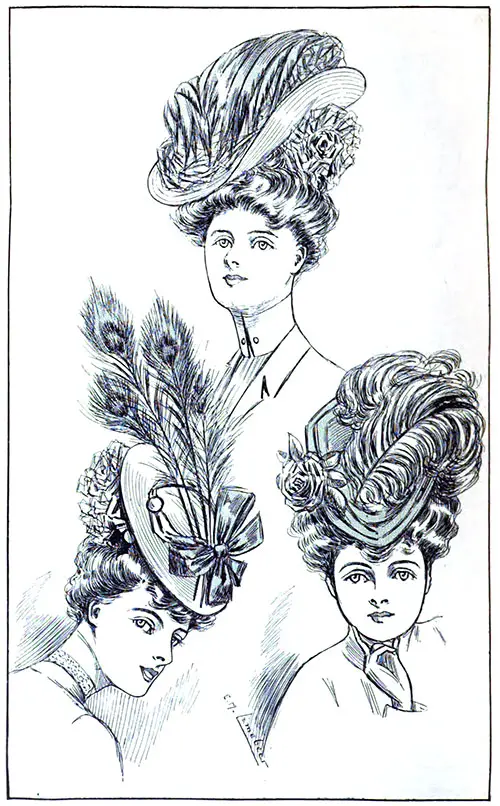
Figure 3: Three Smart Hats from Paquin's
A chat with Paquin, of Dover Street, convinces me that millinery is now at its best, and there is so much variety that every face can be suited. A charming trio of hats has been sketched at the Maison Paquin, indicating some of the modes of the hour.
Here we note that peacocks feathers (in spite of superstition), ostrich plumes, fancy wings, flowers, and ruchings are the favorite trimming for headgear.
The lace hat is pretty for the young girl. White lace, with garlands of flowers and tulle, sounds fundamentally right for the month of roses. Such huge roses are being worn in millinery, and of every possible shade.
All flowers today are wonderfully reproduced, but the rose is the prime favorite. Laying down specific rules regarding millinery is useless. For instance, at a house like Paquin’s you will see some curious flowers of autumnal shading on an essentially June hat.
There is no congruity in the mind of the master milliner, but there is always a good style and a beautiful blending of colors.
The Shepherdess and Watteau shapes remain with us, and their dainty prettiness always goes well with the muslin frock. Then we have ostrich and lace stoles, spangled scarves, and all sorts of beautiful neckgear of this description.
The coquets feather boa will pass muster when it is the good of its kind: but in poor qualities, it should be left severely alone. Neat tulle bows in various colors are worn again by well-dressed women.
A good many foulard and Tussore will doubtless be seen at Ascot, but, of course, one never knows what the weather is going to do.
The Smartest Frocks
Fine clothes are always prepared for this great meeting, but it is probable that there will be at least one dull day. Therefore Tussore will compose some of the smartest frocks; it will be of a coarse make, trimmed with lace dyed to match, worked with gold and silver and further embroidered.
Tussore and a very soft taffetas-mousseline will form the favorite dust-cloaks, now correctly called motor-coats, to wear when going to the course.
These fabrics make such charming pelisses, striking a note out of the common: and they are dust-resisting as well as becoming. No such thing as a dowdy garment is now allowed in fashion’s list.
Modern Motor Coats and Traveling Wraps
When one calls to mind the dust-cloaks of yore and compares them with the contemporary motor-coat and traveling-wrap, one realizes how much sartorial art has improved of late.
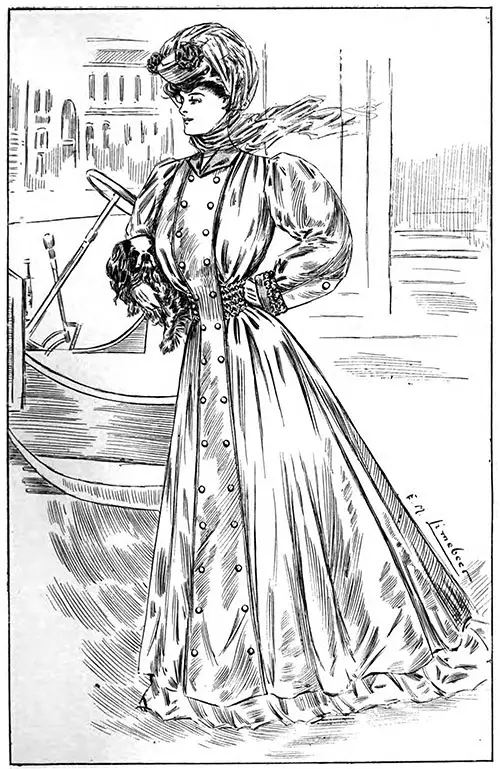
Figure 4: Ascot Dust Coat
A pretty example is sketched in fig. 4 which would be equally charming in taffetas mousseline or Tussore. It is cut after the style of the pelisse, gauged in a proper fashion at the waist, with a wide pleat in front finished with silk braid buttons in a gun-metal rim.
The collar and cuffs are of mirror velvet of the same shade. This is worn with one of the most suitable and useful forms of a motoring hat. Coats of this length in alpaca will be used a great deal for traveling and may be a good investment.
I suppose the most popular shape in cloaks is still the Empire, though it has seen many variations of late: the bodice occasionally shows a cross-over effect.
Very pretty are those in white cloth having a network at the top of black and gold and perhaps a border of the same at the feet. As I have said, cloaks are no longer dowdy; from the cheapest serge to a gorgeous chiffon-velour everything can have a style of its own.
One of the newest and most fantastic forms of a cape is a network of black chenille, lined with chiffon, and embroidered with substantial white Irish crochet roses with jet centers: jet sequins are worked in here and there and give a Spangled, light effect. The wearing of jet black with summer garb always seems so immensely chic and strikes a note of unconventionality.
Very pretty too, as well as useful, are the ankle-length linen coats, with big revers or waistcoats of Irish crochet, or in many cases imitation Irish crochet, the price of the former being prohibitive for the general public.
White Reigns Supreme
White indeed reigns supreme, and coarse white linen blouses and skirts, and coats and skirts are among the smartest costumes for the average dresser on a moderate income.
How pretty they are in all-white, and again they are equally attractive in pale blue and pink embroidered with big white flowers.
Court Frocks
However, before entering the realms of economical dressing let me refer for a few moments to the subject of court frocks, which though somewhat belated will be the most gorgeous in my view.
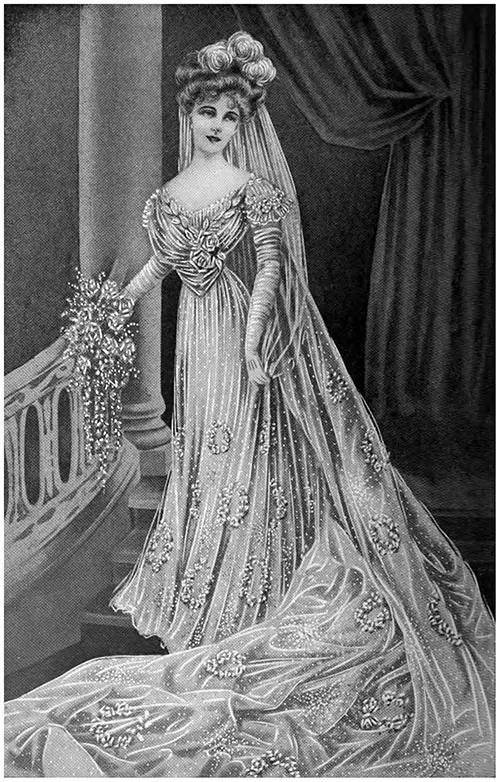
Figure 5: Débuntanté's Court Gown
Our artist has given us a sketch in fig. 5 of a debutante’s costume which is indicative of the best evening dress of the hour. Over softest satin and lined with chiffon is a white tulle robe bespangled with silver and pearl, with a raised Pompadour design of tiny silver roses.
The prettily draped bodice shows an inner chemisette of softest tulle and is also outlined and finished with silver roses. The court train is of tulle lined with silver tissue.
The whole idea is exquisitely light and seems ideal for a fair young girl who is entering in her first season. This frock would be pretty, too, in chiffon-voile spangled in silver and pearls, without the more expensive wreaths of silver roses.
What a craze there is for silver as well as for gun-metal! Some of the newest Paris models for demi-dresses and reception gowns show this gun-metal tissue lightly veiled in net or lace and cunningly mixed with black or jet.
However, to return to the subject of court frocks. Some of the best are cut en Princesse in chiffon velour of white and pale shades, the seams outlined with silver or gold and beautiful entredeux of lace.
The Princess Frock of Today
There are various ways of cutting the Princess frock of today. The bodices of some are beautifully folded, but perhaps the best line is that which is cut in pinafore fashion with entredeux of lace and tulle outlining the décolletage.
Velvet, too, especially in black, is gorgeously outlined with jet or steel, with a train embroidered to match. I should say most of the best frocks have the train to tone in color, even if it be not of the same fabric.
There is a new pale shade of lavender, which, embroidered in silver and dull gold, is extremely useful and lends itself admirably to the court frock with a train of a deeper shade.
Some are made entirely of lace. A somewhat new model was of flame-colored ninon-de-soie with an over-dress of lace dyed the same shade and a train to match, the latter being lined with golden tissue, and the whole gown being lightly spangled with gold, the only relief being a chemisette of white tulle.
Garden Party Frock
Next month I hope to tell you of the new muslins, which are quite charming, but now I must be content with just describing that sketched by our artist in fig. 6. This is a black-and-white check muslin and would make an admirable garden-party frock for half-mourning wear.
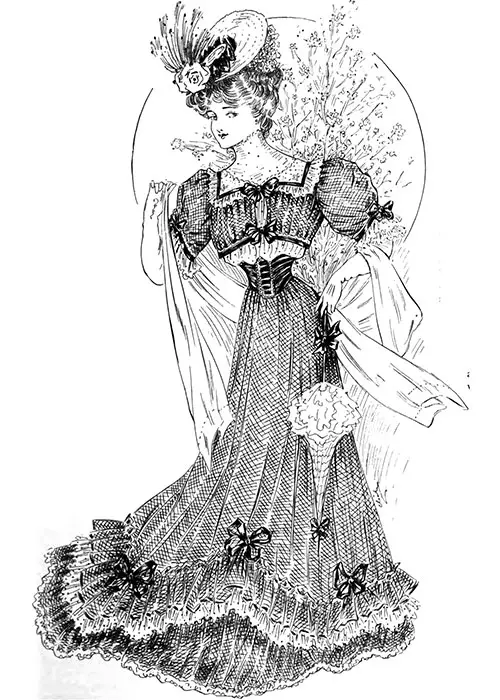
Figure 6: Garden Party Frock in Checked Muslin
The cute little bolero is worn over a blouse made of spotted net, and a frill of the same appears on the skirt, which is full at the feet and is caught at intervals with bows of black velvet ribbon.
A little-embroidered muslin and some more black velvet ribbon are used to trim the bolero, and encircling the waist is a thick belt of softest black chiffon velvet.
The Attractive Tea Gown
I always think the most attractive part of a woman’s wardrobe is the tea-gown, for here individual taste is allowed full play.
A tea-gown which expresses nothing of the individuality of the wearer is generally a failure. Most of us require a tea-gown in the country that can be slipped on for dinner. In some cases, there is as much in the tea-gown as in the picture frock.
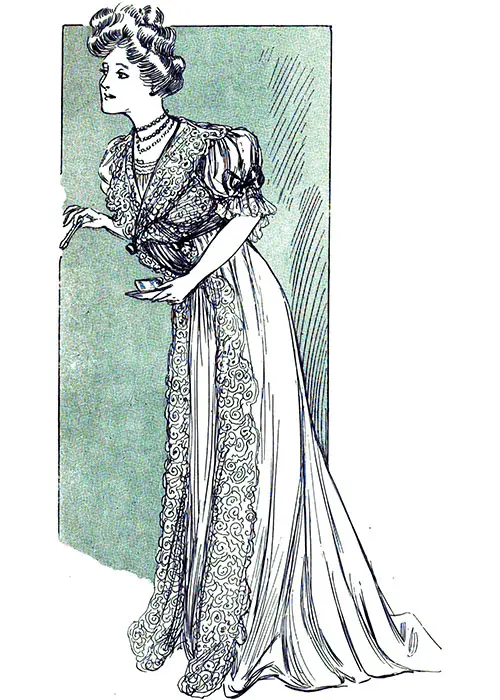
Figure 7: Tea Gown in Ninon-de-Soie and Guipure
In fig. Seven we have a sketch of a pretty tea-gown for five-o’clock or dinner wear in a pale shade of pink ninon-de-soie with an Empire bolero of coarse cream guipure, which also forms the trimming down the front of the skirt.
A nice little chemisette of washing muslin can be let into the V in front, and the sash under the arms is of silver ribbon.
Such a garment as this is easily made and would be utterly charming in pin-spotted muslin, or one of the new sprigged muslins over soft silk underdress.
Washing satin, too, is an ideal fabric for the purpose and requires no lining. Another inexpensive and effective mixture is composed of white cashmere and coarse lace.
I think there is nothing so charming in the summer months as a white muslin or pain! d’esprit tea-gown with a collar of lace, and either a high-waisted band or a girdle drawn downwards.
The tea-gown, the peignoir and the sant de lit are all suggestive of luxury and comfort but need not necessarily be expensive; at the same time, they add significantly to the daintiness of one’s wardrobe.
The Indispensable Blouse
Blouses, too, are indispensable at all times of the year. Coarse linen is the favorite for the river, but for the afternoon all sorts of cute little plain and spotted muslin blouses are worn, and very inexpensive some of them are.
An incredible selection is obtainable at the London Corset Company’s, 28, New Bond Street, W., with cute accessories in the way of stocks, ties, waistbands, etc., all bearing the stamp of Parisian chic.
However, it is not for blouses alone that one goes to 28, New Bond Street, W. This firm is, indeed, especially famous for their corsets of lovely fabric, real whalebone, and perfect cut.
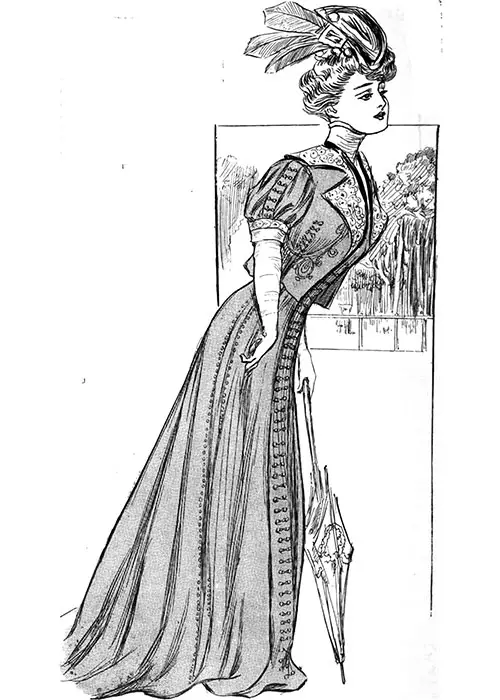
Figure 8: Cloth Dress for a Dull Day at Ascot
In fig. 8 we see the sketch of a costume which was designed initially for a dull day at Ascot, to be carried out in braided cloth and guipure.
In my opinion, it also merits the attention of the woman of limited means who requires a "best” dress for various occasions, for it is smart enough for town wear, and would indeed not be out of place at any country festivity.
Pritchard, Mrs. Eric, “London & Paris Fashions,” in The Lady’s Realm: An Illustrated Monthly Magazine, London: Hutchinson and Company, Vol. XX, No. 2, June 1906, p. 229-239
Terminology
Tussore is coarse silk from the larvae of the tussore moth and related species. Tussore is coarse silk from the larvae of the tussore moth and related species. (Oxford University Press)
Entredeux - Something placed between two things; insertion. (French from entre [between] and deux [two]). (Merriam-Webster)
Editor's Note: Some terminology used in the description of women's clothing during the 1800s and early 1900s has been changed to reflect more modern terms. For example, a women's "Toilette" -- a form of costume or outfit has an entirely different common meaning in the 21st century. Typical terms applied to "toilette" include outfit, ensemble, or costume, depending on context.
Note: We have edited this text to correct grammatical errors and improve word choice to clarify the article for today’s readers. Changes made are typically minor, and we often left passive text “as is.” Those who need to quote the article directly should verify any changes by reviewing the original material.
